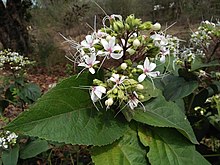| Clerodendrum infortunatum | |
|---|---|

| |
| Scientific classification | |
| Kingdom: | Plantae |
| Clade: | Tracheophytes |
| Clade: | Angiosperms |
| Clade: | Eudicots |
| Clade: | Asterids |
| Order: | Lamiales |
| Family: | Lamiaceae |
| Genus: | Clerodendrum |
| Species: | C. infortunatum |
| Binomial name | |
| Clerodendrum infortunatum L. | |
| Synonyms | |
| |

Clerodendrum infortunatum, known as bhat or hill glory bower, is a perennial shrub belonging to the family Lamiaceae, also sometimes classified under Verbenaceae. It is the type species among ~150 species of Clerodendrum. It is one of the most well-known natural health remedies in traditional practices and siddha medicine.
The species is native to tropical regions of Asia including Bangladesh, India, Myanmar, Pakistan, Thailand, Malaysia, the Andaman Islands, and Sri Lanka.
Description



Clerodendrum infortunatum is a flowering shrub or small tree, and is so named because of its rather ugly leaf . The stem is erect, 0.5–4 m (1.6–13.1 ft) high, with no branches and produce circular leaves with 15 cm (5.9 in) diameter. Leaves are simple, opposite; both surfaces sparsely villous-pubescent, elliptic, broadly elliptic, ovate or elongate ovate, 3.5–20 cm (1.4–7.9 in) wide, 6–25 cm (2.4–9.8 in) long, dentate, inflorescence in terminal, peduncled, few-flowered cyme; flowers white with purplish pink or dull-purple throat, pubescent. Fruit berry, globose, turned bluish-black or black when ripe, enclosed in the red accrescent fruiting-calyx. The stem is hollow and the leaves are 15–20 cm (5.9–7.9 in) long, borne in whorls of four on very short petioles. The inflorescence is huge, consisting of many tubular snow white flowers in a terminal cluster up to 0.6 m (2 ft) long. The tubes of the flowers are about 10 cm (3.9 in) long and droop downward, and the expanded corollas are about 5 cm (2.0 in) across.

The fruits are attractive dark metallic blue drupes, about 1 cm (0.4 in) in diameter. Fruit usually with four dry nutlets and the seeds may be with or without endosperm. It flowers from April to August.
Chemical constituents
The major compounds are sterols, sugars, flavonoids and saponins. Novel crystalline compounds such as clerodolone, clerodone, clerodol, and a sterol designated clerosterol have been isolated from the root. Seven sugars namely raffinose, lactose, maltose, sucrose, galactose, glucose and fructose were identified. Fumaric acid, caffeic acid esters, β-sitosterol and β-sitosterol glucoside were isolated from the flowers. Apigenin, acacetin and a new flavone glycoside, characterised as the methyl ester of acacetin-7-0-glucuronide are isolated from the flowers. Saponin is one of the major compounds of the leaf. 24 beta-ethylsterols, clerosterol and 22-dehydroclerosterol, 24-methyl-sterols (24-methylcholestanol, 24-methylcholesterol, 24-methyl-22-dehydrocholesterol, and 24-methyllathostero) and 24 beta-ethyl-22-dehydrocholestanol are found in the seeds. Scutellarin and hispidulin-7-O-glucuronide are present in the leaf. Poriferasterol and stigmasterol are the components of the aerial parts.
Traditional herbal medicine
Clerodendrum infortunatum is used in Ayurvedic and Siddha traditional medicines. Fresh leaves are given for diarrhea, liver disorders, and headache. The leaf and root are used as antidandruff, antipyretic, ascaricide, laxative, vermifuge, anticonvulsant, antidiabetic, and for gravel, malaria, scabies, skin diseases, sores, spasm, scorpion sting, snake bite, and tumors. In many traditional practices the leaves and root are widely used as antihyperglycemic.
References
- ^ Kew World Checklist of Selected Plant Families
- ^ Manzoor-Khuda M, Sarela S (1965). "Constituents of Clerodendron infortunatum (bhat)—I : Isolation of clerodolone, clerodone, clerodol and clerosterol". Tetrahedron. 21 (4): 797–802. doi:10.1016/0040-4020(65)80012-6.
- ^ Jayaweera DMA (982). Medicinal Plants (Indigenous and Exotic) Used in Ceylon Part V. The National Science Council of Sri Lanka, Colombo, pp. 160-161
- Sinha NK, Pandey VB, Shah AH, Dasgupta B (1980). "Chemical constituents of the flowers of Clerodendron infortunatum". Indian Journal of Pharmaceutical Sciences. 42 (3): 96–97.
- Sinha NK, Seth KK, Pandey VB, Dasgupta B, Shah AH (1981). "Flavonoids from the flowers of Clerodendron infortunatum". Planta Med. 42 (7): 296–298. doi:10.1055/s-2007-971645. PMID 17401979.
- Pal D, Sannigrahi S, Mazumder UK (2009). "Analgesic and anticonvulsant effects of saponin isolated from the leaves of Clerodendrum infortunatum Linn. in mice" (PDF). Indian J Exp Biol. 47 (9): 743–747. PMID 19957887.
- Akihisa T, Matsubara Y, Ghosh P, Thakur S, Tamura T, Matsumoto T (1989). "Sterols of some Clerodendrum species (Verbenaceae): occurrence of the 24 alpha- and 24 beta-epimers of 24-ethylsterols lacking a delta 25-bond". Steroids. 53 (3–5): 625–638. doi:10.1016/0039-128x(89)90036-6. PMID 2799860. S2CID 140208660.
- Subramanian SS, Nair AG (1973). "Scutellarin and hispidulin-7-O-glucuronide from the leaves of Clerodendrum indicum and Clerodendron infortunatum". Phytochemistry. 12 (5): 1195. doi:10.1016/0031-9422(73)85054-X.
- Akihisa T, Matsubara Y, Ghosha P, Thakura S, Shimizub N, Tamura T, Matsumoto T (1988). "The 24a- and 24ß-epimers of 24-ethylcholesta-5,22-dien-3ß-ol in two Clerodendrum species". Phytochemistry. 27 (4): 1169–1172. doi:10.1016/0031-9422(88)80296-6.
- Khare, CP, ed. (2008). Indian Medicinal Plants: An Illustrated Dictionary. Springer-verlag. p. 160. ISBN 978-0-387-70637-5.
- Duke JA (2010). Ethnobotanical uses: Clerodendrum infortunatum. Dr. Dukes's Phytochemical and Ethnobotanical Database
- Sharma HK, Chhangte L, Dolui AK (2001). "Traditional medicinal plants in Mizoram, India". Fitoterapia. 72 (2): 146–161. doi:10.1016/S0367-326X(00)00278-1. PMID 11223224.
- Rahman AU, Zaman K (1989). "Medicinal plants with hypoglycemic activity". J Ethnopharmacol. 26 (1): 1–55. doi:10.1016/0378-8741(89)90112-8. PMID 2664356.
External links
 Data related to Clerodendrum infortunatum at Wikispecies
Data related to Clerodendrum infortunatum at Wikispecies Media related to Clerodendrum infortunatum (category) at Wikimedia Commons
Media related to Clerodendrum infortunatum (category) at Wikimedia Commons- "Clerodendrum infortunatum". Germplasm Resources Information Network. Agricultural Research Service, United States Department of Agriculture.
- The Linnean Collection
- Clerodendrum viscosum Vent. - VERBENACEAE
- Indian Medicinal Plants Growers' Consortium
- Cybernome
- Tropicos
- Flowers of India
| Taxon identifiers | |
|---|---|
| Clerodendrum infortunatum | |